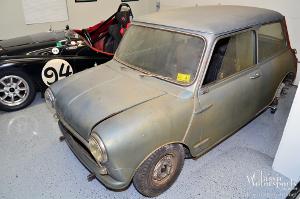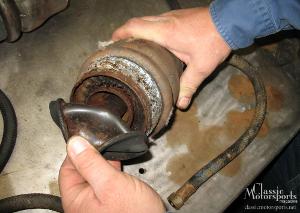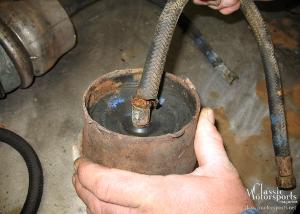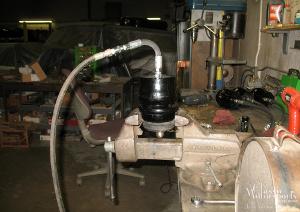Rebuilding the Hydrolastic Displacers
May 23, 2013
|
Our Mini rolled into our shop like this, its suspension all gone bad.
|
The inner rubber displacer unit is molded to an outer metal shell. Usually, these units aren't damaged. |
The problem with these units are the line brekas, which render them useless.
|
The final step is to pressure test the newly built displacer unit.
|
In the mid ’60s, Minis were equipped with what was called Hydrolastic suspension. Commonly called a “wet” suspension system, these cars were equipped with hydraulic displacer units that allowed compressed fluid (water mixed with antifreeze) to move back and forth slowly from front to rear as the car hit bumps in the road. Surprisingly, even without the use of conventional shocks and springs, this system made for a much better-riding Mini. Some would argue that the handling was not as sharp, as on the earlier (and later) more conventional “dry” suspension cars.
Many Mini experts told us to get rid of the troublesome wet suspension system and convert to springs and shocks. A few, like Kip Lankenau of Kip Motor Company, told us the wet suspension worked wonderfully if rebuilt properly, and he was one of the few people on the planet who’d figured out how to repair these nearly unobtainable displacer units.
Our curiosity, not to mention our desire to restore and not modify this neat little car, made us follow Kip’s pitch. We sent him the displacers—bags, as they’re commonly called. We also realized that if we didn’t like the wet suspension, we could always change to a dry system later.
As Kip explained, the displacer units themselves are very durable; it’s rotten attachment hoses that render them unusable. Kip also told us the one thing that can damage the displacer unit itself: jumping your wet-suspension Mini, like they did in the movies.
The displacer unit is molded and crimped into a metal container using a hydraulic press; it doesn’t come apart. And, of course, you’ll ruin the rubber bag-type device if you try to weld or solder a new hose onto it.
Kip has devised a proprietary system of soldering a new hose under water, so that the original displacer unit is not damaged. He’s done 30-40 units successfully and tells us that even if you could figure out his system, the failure rate in attempting the process is so high that you’d soon tire of the ordeal and call Kip Motor Company to take over the job.
This is tricky, and after every repair, the process has to be leak-checked. Kip told us it would take a competent professional 20 tries or more to get one right.
At around $1500 per car (four displacers), this service is not cheap. But only a few NOS displacer units are left in the world, so Kip Motor Company is providing a vital service to the Mini community.












